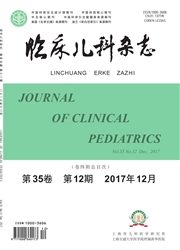

 中文摘要:
中文摘要:
目的 分析苏州地区白血病患儿人微小病毒B19(VB19)感染特点和预后。方法 应用聚合酶链反应方法,对收治的白血病患儿进行VB19定性测定;阳性者予人血丙种球蛋白、更昔洛韦联合中药治疗,根据VB19转阴时间,结合临床症状、血常规进行疗效评估比较。结果 824例白血病患儿的3009份标本中,VB19阳性检出36份,阳性率1.2%,涉及患儿12例,患儿阳性率1.5%。582例急性淋巴细胞白血病患儿中11例阳性,阳性率1.9%;212例急性髓细胞性白血病患儿中1例VB19阳性,阳性率0.45%。12例检出VB19阳性患儿的病程阶段分别为,初诊3例,早期巩固期2例,延迟强化期4例,维持化疗期3例。对9例患儿进行疗效评估,治疗敏感4例,持续2例,耐药3例。耐药患儿中2例发生纯红细胞再生障碍性贫血,1例经治疗VB19转阴,红系造血恢复;1例VB19持续阳性,纯红细胞再生障碍性贫血进展。结论 急性淋巴细胞白血病儿童VB19阳性多见于延迟强化阶段,VB19持续存在可能是导致纯红细胞再生障碍性贫血的重要因素。
 英文摘要:
英文摘要:
Objective To explore the effect of parvovirus B19(VB19)infection on pediatric leukemia patients.MethodsThe pediatric leukemia patients were enrolled in the study in the Children's Hospital of Soochow University.Expression levelsof VB19-DNA-PCR were detected using the polymerase chain reaction.Positive patients would be monitored and treated byconventional treatment as well until VB19gene became negative.The data was compared according to the VB19clearance time,clinical symptoms and blood counts to evaluate the effect.Results In the3009samples from824pediatric leukemia patients,there were36samples(1.2%)from12cases(1.5%)of pediatric leukemia paients with positive VB19infection.Among thepositive patients,11cases(1.9%)were from582with acute lymphoblastic leukemia(ALL)patients and1(0.45%)was from212with acute myeloid leukemia(AML).According to the treatment stage,3cases were in initially diagnosed period,2casesin early stage of consolidation chemotherapy,4cases in delayed enhanced chemotherapy period,and3cases in maintenancechemotherapy period.According to the treatment response,4cases were in continuous treatment,2cases were sensitive totreatment,and3cases were drug resistant.In the drug resistance group,2cases developed into the pure red cell aplastic anemia(PRCA).After treatment,one was recovered from PRCA with VB19cleared,the other one remained PRCA with continuouslypositive VB19.Conclusions More VB19virus infection in pediatric ALL happened in delayed enhanced chemotherapy period.The persistent presence of VB19infection on pediatric leukemia patients is closely related with PRCA.
 同期刊论文项目
同期刊论文项目
 同项目期刊论文
同项目期刊论文
 期刊信息
期刊信息
